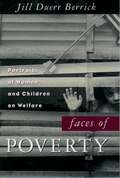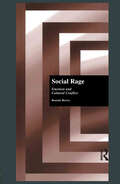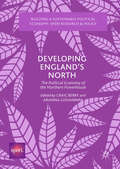- Table View
- List View
Noch mehr Sand im Getriebe?: Kommunikations- und Interaktionsprozesse zwischen Landes- und Regionalplanung, Politik und Unternehmen der Gesteinsindustrie (RaumFragen: Stadt – Region – Landschaft)
by Karsten Berr Corinna Jenal Lara Koegst Olaf KühneObwohl mineralische Rohstoffe wie beispielsweise Kies, Sand, Quarz und Naturstein auf vielfältige Weise Grundlagen menschlicher Existenz ermöglichen und garantieren, haben Vorhaben zur Gewinnung mineralischer Rohstoffe vielerorts mit unterschiedlichen Akzeptanzproblemen zu kämpfen. Der planerische Umgang mit Rohstoffsicherung und Rohstoffgewinnung wurde wissenschaftlich bislang hauptsächlich in Bezug auf ökologische oder fachplanerische Problemstellungen, weniger hingegen als teilsystemischer Aspekt in einem soziopolitischen Kontext betrachtet, der durch verstärkten Bürgerprotest und erneuerte Partizipations- und Demokratisierungsbestrebungen gekennzeichnet ist.
"Und das ungeheure Bild der Landschaft…“: The Genesis of Landscape Understanding in the German-speaking Regions (RaumFragen: Stadt – Region – Landschaft)
by Karsten Berr Olaf KühneThe understanding of landscape in the German-speaking area has some similarities with the discussions of the topic in other European languages and scientific communities, but there are some specifics. These specifics can be found both in the common sense understanding of landscape and in the history of scientific conceptualization. Special features of the common sense understanding lie on the one hand in the medieval roots, a strong romantic charge and the strong connection between home and landscape. With regard to the scientific examination of landscape, there are specific fractions and discontinuities in the German-speaking world.Contents• Theoretical Framing: the Creation of Landscape• The Genesis of the Landscape Concept in the German Language Regions – the Common Sense Understanding• The Concept of Landscape in Landscape-Related Sciences• Landscape Research in its Interdisciplinary and Transdisciplinary ChallengeAbout the AuthorsDr. Karsten Berr works as a research assistant at the Department for Urban and Regional Development at the Eberhard Karls University Tübingen.Dr. Dr. Olaf Kühne is professor for Urban and Regional Development at the Eberhard Karls University Tübingen.
The Enigma of Diversity: The Language of Race and the Limits of Racial Justice
by Ellen BerreyDiversity these days is a hallowed American value, widely shared and honored. That’s a remarkable change from the Civil Rights era—but does this public commitment to diversity constitute a civil rights victory? What does diversity mean in contemporary America, and what are the effects of efforts to support it? Ellen Berrey digs deep into those questions in The Enigma of Diversity. Drawing on six years of fieldwork and historical sources dating back to the 1950s and making extensive use of three case studies from widely varying arenas—housing redevelopment in Chicago’s Rogers Park neighborhood, affirmative action in the University of Michigan’s admissions program, and the workings of the human resources department at a Fortune 500 company—Berrey explores the complicated, contradictory, and even troubling meanings and uses of diversity as it is invoked by different groups for different, often symbolic ends. In each case, diversity affirms inclusiveness, especially in the most coveted jobs and colleges, yet it resists fundamental change in the practices and cultures that are the foundation of social inequality. Berrey shows how this has led racial progress itself to be reimagined, transformed from a legal fight for fundamental rights to a celebration of the competitive advantages afforded by cultural differences. Powerfully argued and surprising in its conclusions, The Enigma of Diversity reveals the true cost of the public embrace of diversity: the taming of demands for racial justice.
The Enigma of Diversity: The Language of Race and the Limits of Racial Justice
by Ellen BerreyDiversity these days is a hallowed American value, widely shared and honored. That’s a remarkable change from the Civil Rights era—but does this public commitment to diversity constitute a civil rights victory? What does diversity mean in contemporary America, and what are the effects of efforts to support it? Ellen Berrey digs deep into those questions in The Enigma of Diversity. Drawing on six years of fieldwork and historical sources dating back to the 1950s and making extensive use of three case studies from widely varying arenas—housing redevelopment in Chicago’s Rogers Park neighborhood, affirmative action in the University of Michigan’s admissions program, and the workings of the human resources department at a Fortune 500 company—Berrey explores the complicated, contradictory, and even troubling meanings and uses of diversity as it is invoked by different groups for different, often symbolic ends. In each case, diversity affirms inclusiveness, especially in the most coveted jobs and colleges, yet it resists fundamental change in the practices and cultures that are the foundation of social inequality. Berrey shows how this has led racial progress itself to be reimagined, transformed from a legal fight for fundamental rights to a celebration of the competitive advantages afforded by cultural differences. Powerfully argued and surprising in its conclusions, The Enigma of Diversity reveals the true cost of the public embrace of diversity: the taming of demands for racial justice.
The Enigma of Diversity: The Language of Race and the Limits of Racial Justice
by Ellen BerreyDiversity these days is a hallowed American value, widely shared and honored. That’s a remarkable change from the Civil Rights era—but does this public commitment to diversity constitute a civil rights victory? What does diversity mean in contemporary America, and what are the effects of efforts to support it? Ellen Berrey digs deep into those questions in The Enigma of Diversity. Drawing on six years of fieldwork and historical sources dating back to the 1950s and making extensive use of three case studies from widely varying arenas—housing redevelopment in Chicago’s Rogers Park neighborhood, affirmative action in the University of Michigan’s admissions program, and the workings of the human resources department at a Fortune 500 company—Berrey explores the complicated, contradictory, and even troubling meanings and uses of diversity as it is invoked by different groups for different, often symbolic ends. In each case, diversity affirms inclusiveness, especially in the most coveted jobs and colleges, yet it resists fundamental change in the practices and cultures that are the foundation of social inequality. Berrey shows how this has led racial progress itself to be reimagined, transformed from a legal fight for fundamental rights to a celebration of the competitive advantages afforded by cultural differences. Powerfully argued and surprising in its conclusions, The Enigma of Diversity reveals the true cost of the public embrace of diversity: the taming of demands for racial justice.
The Enigma of Diversity: The Language of Race and the Limits of Racial Justice
by Ellen BerreyDiversity these days is a hallowed American value, widely shared and honored. That’s a remarkable change from the Civil Rights era—but does this public commitment to diversity constitute a civil rights victory? What does diversity mean in contemporary America, and what are the effects of efforts to support it? Ellen Berrey digs deep into those questions in The Enigma of Diversity. Drawing on six years of fieldwork and historical sources dating back to the 1950s and making extensive use of three case studies from widely varying arenas—housing redevelopment in Chicago’s Rogers Park neighborhood, affirmative action in the University of Michigan’s admissions program, and the workings of the human resources department at a Fortune 500 company—Berrey explores the complicated, contradictory, and even troubling meanings and uses of diversity as it is invoked by different groups for different, often symbolic ends. In each case, diversity affirms inclusiveness, especially in the most coveted jobs and colleges, yet it resists fundamental change in the practices and cultures that are the foundation of social inequality. Berrey shows how this has led racial progress itself to be reimagined, transformed from a legal fight for fundamental rights to a celebration of the competitive advantages afforded by cultural differences. Powerfully argued and surprising in its conclusions, The Enigma of Diversity reveals the true cost of the public embrace of diversity: the taming of demands for racial justice.
The Enigma of Diversity: The Language of Race and the Limits of Racial Justice
by Ellen BerreyDiversity these days is a hallowed American value, widely shared and honored. That’s a remarkable change from the Civil Rights era—but does this public commitment to diversity constitute a civil rights victory? What does diversity mean in contemporary America, and what are the effects of efforts to support it? Ellen Berrey digs deep into those questions in The Enigma of Diversity. Drawing on six years of fieldwork and historical sources dating back to the 1950s and making extensive use of three case studies from widely varying arenas—housing redevelopment in Chicago’s Rogers Park neighborhood, affirmative action in the University of Michigan’s admissions program, and the workings of the human resources department at a Fortune 500 company—Berrey explores the complicated, contradictory, and even troubling meanings and uses of diversity as it is invoked by different groups for different, often symbolic ends. In each case, diversity affirms inclusiveness, especially in the most coveted jobs and colleges, yet it resists fundamental change in the practices and cultures that are the foundation of social inequality. Berrey shows how this has led racial progress itself to be reimagined, transformed from a legal fight for fundamental rights to a celebration of the competitive advantages afforded by cultural differences. Powerfully argued and surprising in its conclusions, The Enigma of Diversity reveals the true cost of the public embrace of diversity: the taming of demands for racial justice.
The Enigma of Diversity: The Language of Race and the Limits of Racial Justice
by Ellen BerreyDiversity these days is a hallowed American value, widely shared and honored. That’s a remarkable change from the Civil Rights era—but does this public commitment to diversity constitute a civil rights victory? What does diversity mean in contemporary America, and what are the effects of efforts to support it? Ellen Berrey digs deep into those questions in The Enigma of Diversity. Drawing on six years of fieldwork and historical sources dating back to the 1950s and making extensive use of three case studies from widely varying arenas—housing redevelopment in Chicago’s Rogers Park neighborhood, affirmative action in the University of Michigan’s admissions program, and the workings of the human resources department at a Fortune 500 company—Berrey explores the complicated, contradictory, and even troubling meanings and uses of diversity as it is invoked by different groups for different, often symbolic ends. In each case, diversity affirms inclusiveness, especially in the most coveted jobs and colleges, yet it resists fundamental change in the practices and cultures that are the foundation of social inequality. Berrey shows how this has led racial progress itself to be reimagined, transformed from a legal fight for fundamental rights to a celebration of the competitive advantages afforded by cultural differences. Powerfully argued and surprising in its conclusions, The Enigma of Diversity reveals the true cost of the public embrace of diversity: the taming of demands for racial justice.
Rights on Trial: How Workplace Discrimination Law Perpetuates Inequality
by Ellen Berrey Robert L. Nelson Laura Beth NielsenGerry Handley faced years of blatant race-based harassment before he filed a complaint against his employer: racist jokes, signs reading “KKK” in his work area, and even questions from coworkers as to whether he had sex with his daughter as slaves supposedly did. He had an unusually strong case, with copious documentation and coworkers’ support, and he settled for $50,000, even winning back his job. But victory came at a high cost. Legal fees cut into Mr. Handley’s winnings, and tensions surrounding the lawsuit poisoned the workplace. A year later, he lost his job due to downsizing by his company. Mr. Handley exemplifies the burden plaintiffs bear in contemporary civil rights litigation. In the decades since the civil rights movement, we’ve made progress, but not nearly as much as it might seem. On the surface, America’s commitment to equal opportunity in the workplace has never been clearer. Virtually every company has antidiscrimination policies in place, and there are laws designed to protect these rights across a range of marginalized groups. But, as Ellen Berrey, Robert L. Nelson, and Laura Beth Nielsen compellingly show, this progressive vision of the law falls far short in practice. When aggrieved individuals turn to the law, the adversarial character of litigation imposes considerable personal and financial costs that make plaintiffs feel like they’ve lost regardless of the outcome of the case. Employer defendants also are dissatisfied with the system, often feeling “held up” by what they see as frivolous cases. And even when the case is resolved in the plaintiff’s favor, the conditions that gave rise to the lawsuit rarely change. In fact, the contemporary approach to workplace discrimination law perversely comes to reinforce the very hierarchies that antidiscrimination laws were created to redress. Based on rich interviews with plaintiffs, attorneys, and representatives of defendants and an original national dataset on case outcomes, Rights on Trial reveals the fundamental flaws of workplace discrimination law and offers practical recommendations for how we might better respond to persistent patterns of discrimination.
Rights on Trial: How Workplace Discrimination Law Perpetuates Inequality
by Ellen Berrey Robert L. Nelson Laura Beth NielsenGerry Handley faced years of blatant race-based harassment before he filed a complaint against his employer: racist jokes, signs reading “KKK” in his work area, and even questions from coworkers as to whether he had sex with his daughter as slaves supposedly did. He had an unusually strong case, with copious documentation and coworkers’ support, and he settled for $50,000, even winning back his job. But victory came at a high cost. Legal fees cut into Mr. Handley’s winnings, and tensions surrounding the lawsuit poisoned the workplace. A year later, he lost his job due to downsizing by his company. Mr. Handley exemplifies the burden plaintiffs bear in contemporary civil rights litigation. In the decades since the civil rights movement, we’ve made progress, but not nearly as much as it might seem. On the surface, America’s commitment to equal opportunity in the workplace has never been clearer. Virtually every company has antidiscrimination policies in place, and there are laws designed to protect these rights across a range of marginalized groups. But, as Ellen Berrey, Robert L. Nelson, and Laura Beth Nielsen compellingly show, this progressive vision of the law falls far short in practice. When aggrieved individuals turn to the law, the adversarial character of litigation imposes considerable personal and financial costs that make plaintiffs feel like they’ve lost regardless of the outcome of the case. Employer defendants also are dissatisfied with the system, often feeling “held up” by what they see as frivolous cases. And even when the case is resolved in the plaintiff’s favor, the conditions that gave rise to the lawsuit rarely change. In fact, the contemporary approach to workplace discrimination law perversely comes to reinforce the very hierarchies that antidiscrimination laws were created to redress. Based on rich interviews with plaintiffs, attorneys, and representatives of defendants and an original national dataset on case outcomes, Rights on Trial reveals the fundamental flaws of workplace discrimination law and offers practical recommendations for how we might better respond to persistent patterns of discrimination.
Rights on Trial: How Workplace Discrimination Law Perpetuates Inequality
by Ellen Berrey Robert L. Nelson Laura Beth NielsenGerry Handley faced years of blatant race-based harassment before he filed a complaint against his employer: racist jokes, signs reading “KKK” in his work area, and even questions from coworkers as to whether he had sex with his daughter as slaves supposedly did. He had an unusually strong case, with copious documentation and coworkers’ support, and he settled for $50,000, even winning back his job. But victory came at a high cost. Legal fees cut into Mr. Handley’s winnings, and tensions surrounding the lawsuit poisoned the workplace. A year later, he lost his job due to downsizing by his company. Mr. Handley exemplifies the burden plaintiffs bear in contemporary civil rights litigation. In the decades since the civil rights movement, we’ve made progress, but not nearly as much as it might seem. On the surface, America’s commitment to equal opportunity in the workplace has never been clearer. Virtually every company has antidiscrimination policies in place, and there are laws designed to protect these rights across a range of marginalized groups. But, as Ellen Berrey, Robert L. Nelson, and Laura Beth Nielsen compellingly show, this progressive vision of the law falls far short in practice. When aggrieved individuals turn to the law, the adversarial character of litigation imposes considerable personal and financial costs that make plaintiffs feel like they’ve lost regardless of the outcome of the case. Employer defendants also are dissatisfied with the system, often feeling “held up” by what they see as frivolous cases. And even when the case is resolved in the plaintiff’s favor, the conditions that gave rise to the lawsuit rarely change. In fact, the contemporary approach to workplace discrimination law perversely comes to reinforce the very hierarchies that antidiscrimination laws were created to redress. Based on rich interviews with plaintiffs, attorneys, and representatives of defendants and an original national dataset on case outcomes, Rights on Trial reveals the fundamental flaws of workplace discrimination law and offers practical recommendations for how we might better respond to persistent patterns of discrimination.
Rights on Trial: How Workplace Discrimination Law Perpetuates Inequality
by Ellen Berrey Robert L. Nelson Laura Beth NielsenGerry Handley faced years of blatant race-based harassment before he filed a complaint against his employer: racist jokes, signs reading “KKK” in his work area, and even questions from coworkers as to whether he had sex with his daughter as slaves supposedly did. He had an unusually strong case, with copious documentation and coworkers’ support, and he settled for $50,000, even winning back his job. But victory came at a high cost. Legal fees cut into Mr. Handley’s winnings, and tensions surrounding the lawsuit poisoned the workplace. A year later, he lost his job due to downsizing by his company. Mr. Handley exemplifies the burden plaintiffs bear in contemporary civil rights litigation. In the decades since the civil rights movement, we’ve made progress, but not nearly as much as it might seem. On the surface, America’s commitment to equal opportunity in the workplace has never been clearer. Virtually every company has antidiscrimination policies in place, and there are laws designed to protect these rights across a range of marginalized groups. But, as Ellen Berrey, Robert L. Nelson, and Laura Beth Nielsen compellingly show, this progressive vision of the law falls far short in practice. When aggrieved individuals turn to the law, the adversarial character of litigation imposes considerable personal and financial costs that make plaintiffs feel like they’ve lost regardless of the outcome of the case. Employer defendants also are dissatisfied with the system, often feeling “held up” by what they see as frivolous cases. And even when the case is resolved in the plaintiff’s favor, the conditions that gave rise to the lawsuit rarely change. In fact, the contemporary approach to workplace discrimination law perversely comes to reinforce the very hierarchies that antidiscrimination laws were created to redress. Based on rich interviews with plaintiffs, attorneys, and representatives of defendants and an original national dataset on case outcomes, Rights on Trial reveals the fundamental flaws of workplace discrimination law and offers practical recommendations for how we might better respond to persistent patterns of discrimination.
Rights on Trial: How Workplace Discrimination Law Perpetuates Inequality
by Ellen Berrey Robert L. Nelson Laura Beth NielsenGerry Handley faced years of blatant race-based harassment before he filed a complaint against his employer: racist jokes, signs reading “KKK” in his work area, and even questions from coworkers as to whether he had sex with his daughter as slaves supposedly did. He had an unusually strong case, with copious documentation and coworkers’ support, and he settled for $50,000, even winning back his job. But victory came at a high cost. Legal fees cut into Mr. Handley’s winnings, and tensions surrounding the lawsuit poisoned the workplace. A year later, he lost his job due to downsizing by his company. Mr. Handley exemplifies the burden plaintiffs bear in contemporary civil rights litigation. In the decades since the civil rights movement, we’ve made progress, but not nearly as much as it might seem. On the surface, America’s commitment to equal opportunity in the workplace has never been clearer. Virtually every company has antidiscrimination policies in place, and there are laws designed to protect these rights across a range of marginalized groups. But, as Ellen Berrey, Robert L. Nelson, and Laura Beth Nielsen compellingly show, this progressive vision of the law falls far short in practice. When aggrieved individuals turn to the law, the adversarial character of litigation imposes considerable personal and financial costs that make plaintiffs feel like they’ve lost regardless of the outcome of the case. Employer defendants also are dissatisfied with the system, often feeling “held up” by what they see as frivolous cases. And even when the case is resolved in the plaintiff’s favor, the conditions that gave rise to the lawsuit rarely change. In fact, the contemporary approach to workplace discrimination law perversely comes to reinforce the very hierarchies that antidiscrimination laws were created to redress. Based on rich interviews with plaintiffs, attorneys, and representatives of defendants and an original national dataset on case outcomes, Rights on Trial reveals the fundamental flaws of workplace discrimination law and offers practical recommendations for how we might better respond to persistent patterns of discrimination.
Rights on Trial: How Workplace Discrimination Law Perpetuates Inequality
by Ellen Berrey Robert L. Nelson Laura Beth NielsenGerry Handley faced years of blatant race-based harassment before he filed a complaint against his employer: racist jokes, signs reading “KKK” in his work area, and even questions from coworkers as to whether he had sex with his daughter as slaves supposedly did. He had an unusually strong case, with copious documentation and coworkers’ support, and he settled for $50,000, even winning back his job. But victory came at a high cost. Legal fees cut into Mr. Handley’s winnings, and tensions surrounding the lawsuit poisoned the workplace. A year later, he lost his job due to downsizing by his company. Mr. Handley exemplifies the burden plaintiffs bear in contemporary civil rights litigation. In the decades since the civil rights movement, we’ve made progress, but not nearly as much as it might seem. On the surface, America’s commitment to equal opportunity in the workplace has never been clearer. Virtually every company has antidiscrimination policies in place, and there are laws designed to protect these rights across a range of marginalized groups. But, as Ellen Berrey, Robert L. Nelson, and Laura Beth Nielsen compellingly show, this progressive vision of the law falls far short in practice. When aggrieved individuals turn to the law, the adversarial character of litigation imposes considerable personal and financial costs that make plaintiffs feel like they’ve lost regardless of the outcome of the case. Employer defendants also are dissatisfied with the system, often feeling “held up” by what they see as frivolous cases. And even when the case is resolved in the plaintiff’s favor, the conditions that gave rise to the lawsuit rarely change. In fact, the contemporary approach to workplace discrimination law perversely comes to reinforce the very hierarchies that antidiscrimination laws were created to redress. Based on rich interviews with plaintiffs, attorneys, and representatives of defendants and an original national dataset on case outcomes, Rights on Trial reveals the fundamental flaws of workplace discrimination law and offers practical recommendations for how we might better respond to persistent patterns of discrimination.
ADHD in Lebanese Schools: Diagnosis, Assessment, and Treatment (SpringerBriefs in Psychology)
by Hala Mohammed Berri Anies Al-HroubThis Brief addresses the causes, assessment, and treatment of ADHD in Lebanese schoolchildren. It details how the disorder is currently defined in Lebanese elementary schools and examines schoolteachers’ understanding of and conceptions about ADHD across three domains: general knowledge; symptoms and diagnosis; and treatment. This concise volume presents the authors’ research into Lebanese schoolteachers’ knowledge of ADHD and their ability and readiness to address the psychological and academic needs of their students who have been diagnosed with the disorder. In addition, the Brief explores the teachers’ ability to identify ADHD subtypes in relation to a student’s gender within the Lebanese context, emphasizing the differing sociocultural expectations in the behaviors of boys and girls.Current procedures for identifying ADHD in Lebanon. Lebanese teachers’ knowledge about ADHD, their misconceptions, and factors that influence their opinions. Biases toward and confusion about disorders on the basis of perceived gender differences. ADHD assessment and implementation strategies for Lebanese special education professionals.Research questions, design, and methods as well as data collection and analysis procedures used in the study. ADHD in Lebanese Schools is an essential resource for researchers, professionals and policymakers, and graduate students in such interrelated fields as school psychology, educational psychology, and social work.
Methodological Approaches to Societies in Transformation: How to Make Sense of Change (Anthropology, Change, and Development)
by Yasmine Berriane Annuska Derks Aymon Kreil Dorothea LüddeckensThis open access book provides methodological devices and analytical frameworks for the study of societies in transformation. It explores a central paradox in the study of change: making sense of change requires long-term perspectives on societal transformations and on the different ways people experience social change, whereas the research carried out to study change is necessarily limited to a relatively short space of time. This volume offers a range of methodological responses to this challenge by paying attention to the complex entanglement of qualitative research and the metanarratives generally used to account for change. Each chapter is based on a concrete case study from different parts of the world and tackles a diversity of topics, analytical approaches, and data collection methods. The contributors’ innovative solutions provide valuable tools and techniques for all those interested in the study of change.
Faces Of Poverty: Portraits Of Women And Children On Welfare
by Jill Duerr BerrickMost Americans are insulated from the poor; it's hard to imagine the challenges of poverty, the daily fears of crime and victimization, the frustration of not being able to provide for a child. Instead, we are often exposed to the rhetoric and hyperbole about the excesses of the American welfare system. These messages color our perception of the welfare problem in the United States and they close the American mind to a full understanding of the complexity of family poverty. But who are these poor families? What do we know about how they arrived in such desperate straits? Is poverty their fate for a lifetime or for only a brief period? In Faces of Poverty , Jill Duerr Berrick answers these questions as she dispels the misconceptions and myths about welfare and the welfare population that have clouded the true picture of poverty in America. Over the course of a year, Berrick spent numerous hours as a participant-observer with five women and their families, documenting their daily activities, thoughts, and fears as they managed the strains of poverty. We meet Ana, Sandy, Rebecca, Darlene, and Cora, all of whom, at some point, have turned to welfare for support. Each represents a wider segment of the welfare population--ranging from Ana (who lost a business, injured her back, and temporarily lost her job, all in a short period of time) to Cora (who was raised in poverty, spent ten years in an abusive relationship, and now struggles to raise six children in a drug-infested neighborhood). And as Berrick documents these women's experiences, she also debunks many of the myths about welfare: she reveals that welfare is not generous (welfare families remain below the poverty line even with government assistance); that the majority of women on welfare are not long-term welfare dependents; that welfare does not run in families; that "welfare mothers" do not keep having children to increase their payments (women on welfare have, on average, two children); and that almost half of all women on welfare turned to it after a divorce. At a time when welfare has become a hotly debated political issue, Faces of Poverty gives us the facts. The debate surrounding welfare will continue as each of the 50 states struggles to reform their welfare programs, and this debate will turn on the public's perception of the welfare population. Berrick offers insight into each of the reforms under consideration and starkly demonstrates their implications for poor women and children. She provides a window into these women's lives, brilliantly portraying their hopes and fears and their struggle to live with dignity.
Faces of Poverty: Portraits of Women and Children on Welfare
by Jill Duerr BerrickMost Americans are insulated from the poor; it's hard to imagine the challenges of poverty, the daily fears of crime and victimization, the frustration of not being able to provide for a child. Instead, we are often exposed to the rhetoric and hyperbole about the excesses of the American welfare system. These messages color our perception of the welfare problem in the United States and they close the American mind to a full understanding of the complexity of family poverty. But who are these poor families? What do we know about how they arrived in such desperate straits? Is poverty their fate for a lifetime or for only a brief period? In Faces of Poverty, Jill Duerr Berrick answers these questions as she dispels the misconceptions and myths about welfare and the welfare population that have clouded the true picture of poverty in America. Over the course of a year, Berrick spent numerous hours as a participant-observer with five women and their families, documenting their daily activities, thoughts, and fears as they managed the strains of poverty. We meet Ana, Sandy, Rebecca, Darlene, and Cora, all of whom, at some point, have turned to welfare for support. Each represents a wider segment of the welfare population--ranging from Ana (who lost a business, injured her back, and temporarily lost her job, all in a short period of time) to Cora (who was raised in poverty, spent ten years in an abusive relationship, and now struggles to raise six children in a drug-infested neighborhood). And as Berrick documents these women's experiences, she also debunks many of the myths about welfare: she reveals that welfare is not generous (welfare families remain below the poverty line even with government assistance); that the majority of women on welfare are not long-term welfare dependents; that welfare does not run in families; that "welfare mothers" do not keep having children to increase their payments (women on welfare have, on average, two children); and that almost half of all women on welfare turned to it after a divorce. At a time when welfare has become a hotly debated political issue, Faces of Poverty gives us the facts. The debate surrounding welfare will continue as each of the 50 states struggles to reform their welfare programs, and this debate will turn on the public's perception of the welfare population. Berrick offers insight into each of the reforms under consideration and starkly demonstrates their implications for poor women and children. She provides a window into these women's lives, brilliantly portraying their hopes and fears and their struggle to live with dignity.
Social Rage: Emotion and Cultural Conflict (Sociology/Psychology/Reference)
by Bonnie BerryThis book defines and describes the meaning of social rage by examining the influence of social forces such as economic conditions, population diversity and power shifts. The role of media, in particular its encouragement of social rage through sensationalism, is also handled in this book. The author apporaches the issue of social rage on both an individual and a collective level with the goal of revealing its motivations and its impact.
Social Rage: Emotion and Cultural Conflict (Sociology/Psychology/Reference #Vol. 1187)
by Bonnie BerryThis book defines and describes the meaning of social rage by examining the influence of social forces such as economic conditions, population diversity and power shifts. The role of media, in particular its encouragement of social rage through sensationalism, is also handled in this book. The author apporaches the issue of social rage on both an individual and a collective level with the goal of revealing its motivations and its impact.
Urban Geography in America, 1950-2000: Paradigms and Personalities
by Brian J. L. Berry James O. WheelerFirst published in 2005. Routledge is an imprint of Taylor & Francis, an informa company.
Developing England’s North: The Political Economy of the Northern Powerhouse (Building a Sustainable Political Economy: SPERI Research & Policy)
by Craig Berry Arianna GiovanniniThis book explores the politics of local economic development in Northern England. Socio-economic conditions in the North – and its future prospects – have become central to national debates in the UK. The status of Northern regions and their local economies is intimately associated with efforts to ‘rebalance’ the economy away from the South East, London and the finance sector in the wake of the 2008 financial crisis. The contributors to this volume focus in particular on the coalition and Conservative governments’ ‘Northern Powerhouse’ agenda. They also analyse associated efforts to devolve power to local authorities across England, which promise to bring both greater prosperity and autonomy to the deindustrialized North. Several chapters critically interrogate these initiatives, and their ambitions, by placing them within their wider historical, geographical, institutional and ideological contexts. As such, Berry and Giovannini seek to locate Northern England within a broader understanding of the political dimension of economic development, and outline a series of ideas for enhancing the North’s prospects.
Developing England’s North: The Political Economy of the Northern Powerhouse (Building a Sustainable Political Economy: SPERI Research & Policy)
by Craig Berry Arianna GiovanniniThis book explores the politics of local economic development in Northern England. Socio-economic conditions in the North – and its future prospects – have become central to national debates in the UK. The status of Northern regions and their local economies is intimately associated with efforts to ‘rebalance’ the economy away from the South East, London and the finance sector in the wake of the 2008 financial crisis. The contributors to this volume focus in particular on the coalition and Conservative governments’ ‘Northern Powerhouse’ agenda. They also analyse associated efforts to devolve power to local authorities across England, which promise to bring both greater prosperity and autonomy to the deindustrialized North. Several chapters critically interrogate these initiatives, and their ambitions, by placing them within their wider historical, geographical, institutional and ideological contexts. As such, Berry and Giovannini seek to locate Northern England within a broader understanding of the political dimension of economic development, and outline a series of ideas for enhancing the North’s prospects.
The New Apostolic Reformation, Trump, and Evangelical Politics: The Prophecy Voter
by Damon T. BerryWhilst many assume that conservative evangelical support for Trump is motivated by his position on social issues such as abortion and LGBTQ rights, or a nostalgia for an imagined American golden age, this book shows that the reality is much more complex by looking at a more recent and understudied trend of Evangelicalism in America. Damon T. Berry examines how leaders within the New Apostolic Reformation (NAR), a charismatically inclined Evangelical movement, claim their support for Trump came from alleged prophetic visions that compelled them to defend Trump's candidacy, and to continue to defend his presidency, re-election against demonically inspired, Marxist, “Deep State” enemies. In this conspiratorial cosmology, spiritual warfare through prayer and political activism is the duty of the faithful so that they might protect Trump as God's anointed leader and war against malevolent, unpatriotic forces that oppose him, the nation, and God himself. Working from primary source materials produced by leading figures among the NAR, Berry argues that this conspiratorial discourse is central to NAR support for Trump's candidacy, presidency, and re-election effort, and that this discourse has come to shape some of the most important debates among American religious conservatives in the 21st century.
The New Apostolic Reformation, Trump, and Evangelical Politics: The Prophecy Voter
by Damon T. BerryWhilst many assume that conservative evangelical support for Trump is motivated by his position on social issues such as abortion and LGBTQ rights, or a nostalgia for an imagined American golden age, this book shows that the reality is much more complex by looking at a more recent and understudied trend of Evangelicalism in America. Damon T. Berry examines how leaders within the New Apostolic Reformation (NAR), a charismatically inclined Evangelical movement, claim their support for Trump came from alleged prophetic visions that compelled them to defend Trump's candidacy, and to continue to defend his presidency, re-election against demonically inspired, Marxist, “Deep State” enemies. In this conspiratorial cosmology, spiritual warfare through prayer and political activism is the duty of the faithful so that they might protect Trump as God's anointed leader and war against malevolent, unpatriotic forces that oppose him, the nation, and God himself. Working from primary source materials produced by leading figures among the NAR, Berry argues that this conspiratorial discourse is central to NAR support for Trump's candidacy, presidency, and re-election effort, and that this discourse has come to shape some of the most important debates among American religious conservatives in the 21st century.











